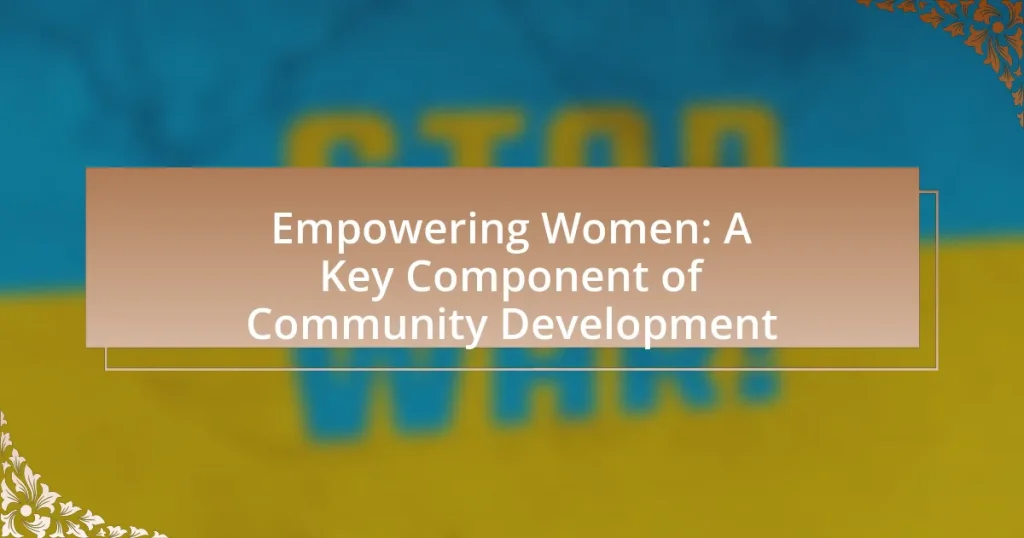Empowering women is a critical aspect of community development, facilitating their active participation in decision-making, resource management, and leadership roles. This empowerment leads to improved social, economic, and political outcomes, benefiting entire communities through enhanced economic growth, reduced poverty, and better health and education. The article explores the historical context of women’s empowerment, the challenges they face, and the key components necessary for achieving empowerment, such as education and economic independence. It also highlights the significant impact of women’s leadership on community resilience and social cohesion, as well as effective strategies and programs that can be implemented to support women’s empowerment initiatives.

What is Empowering Women in Community Development?
Empowering women in community development refers to the process of enabling women to participate actively in decision-making, resource management, and leadership roles within their communities. This empowerment is crucial as it leads to improved social, economic, and political outcomes, benefiting not only women but the entire community. Research indicates that when women are empowered, communities experience enhanced economic growth, reduced poverty levels, and improved health and education outcomes. For instance, a study by the World Bank found that increasing women’s participation in the labor force can significantly boost a country’s GDP.
Why is empowering women considered essential for community development?
Empowering women is essential for community development because it leads to improved economic growth, social stability, and enhanced quality of life. When women are empowered, they contribute significantly to the workforce, which can increase household incomes and stimulate local economies. According to the McKinsey Global Institute, closing gender gaps in labor force participation could add $28 trillion to global GDP by 2025. Furthermore, empowered women are more likely to invest in their families’ health and education, resulting in better outcomes for future generations. This cycle of empowerment fosters sustainable community development, as evidenced by various studies showing that communities with higher female participation in decision-making processes experience greater social cohesion and resilience.
What historical context supports the need for women’s empowerment?
The historical context supporting the need for women’s empowerment includes the long-standing gender inequalities that have marginalized women in various societies. For instance, during the 19th and early 20th centuries, women were largely excluded from political participation, as evidenced by the suffrage movements in countries like the United States and the United Kingdom, where women fought for the right to vote, culminating in the 19th Amendment in 1920 in the U.S. and the Representation of the People Act in 1918 in the U.K. Furthermore, the United Nations’ 1975 International Women’s Year and subsequent conferences highlighted the systemic barriers women face, reinforcing the global recognition of women’s rights as human rights. These historical milestones illustrate the necessity for women’s empowerment as a means to rectify past injustices and promote equitable development in communities.
How does women’s empowerment influence community resilience?
Women’s empowerment significantly enhances community resilience by fostering social cohesion, economic stability, and improved decision-making. Empowered women contribute to community development through increased participation in leadership roles and local governance, which leads to more inclusive and effective responses to challenges. Research indicates that communities with higher levels of women’s empowerment experience better outcomes in disaster recovery and economic growth, as women often reinvest their earnings into their families and communities. For instance, a study by the World Bank found that when women have equal access to resources, the overall economic productivity of a community increases by up to 25%. This correlation demonstrates that empowering women not only strengthens individual capabilities but also fortifies the entire community against various adversities.
What are the key components of women’s empowerment?
The key components of women’s empowerment include education, economic independence, health and well-being, political participation, and social equality. Education equips women with knowledge and skills, leading to better job opportunities and informed decision-making. Economic independence allows women to support themselves and contribute to their communities, enhancing their status and influence. Health and well-being ensure that women have access to necessary healthcare services, which is vital for their overall empowerment. Political participation enables women to have a voice in governance and policy-making, fostering gender equality. Social equality addresses cultural and societal norms that hinder women’s rights and opportunities, promoting a more equitable environment. These components collectively contribute to the empowerment of women, which is essential for sustainable community development.
How do education and skill development contribute to women’s empowerment?
Education and skill development significantly contribute to women’s empowerment by enhancing their knowledge, capabilities, and economic independence. Access to education allows women to acquire essential skills that improve their employability and income potential. For instance, according to UNESCO, each additional year of schooling can increase a woman’s earnings by up to 20%. Furthermore, skill development programs equip women with specific competencies that are in demand in the job market, enabling them to participate actively in the economy. This participation not only fosters individual empowerment but also contributes to broader community development by promoting gender equality and reducing poverty.
What role does economic independence play in empowering women?
Economic independence plays a crucial role in empowering women by providing them with the financial resources and autonomy necessary to make independent choices. When women achieve economic independence, they gain the ability to support themselves and their families, which enhances their decision-making power in both personal and societal contexts. Research indicates that women with financial autonomy are more likely to invest in their children’s education and health, contributing to overall community development. For instance, a study by the World Bank found that women’s economic empowerment can lead to a 20% increase in household spending on education and health, demonstrating the direct impact of economic independence on community well-being.
What challenges do women face in achieving empowerment?
Women face numerous challenges in achieving empowerment, including systemic gender discrimination, limited access to education, and economic inequality. Systemic gender discrimination manifests in various forms, such as cultural norms that prioritize male authority and decision-making, which can hinder women’s participation in leadership roles. Limited access to education restricts women’s opportunities for personal and professional growth; according to UNESCO, 132 million girls worldwide are out of school, which directly impacts their ability to gain skills and knowledge necessary for empowerment. Economic inequality is evident in the gender pay gap, where women earn approximately 77 cents for every dollar earned by men, as reported by the World Economic Forum. These challenges collectively impede women’s ability to achieve full empowerment and contribute effectively to community development.
How do cultural norms impact women’s empowerment efforts?
Cultural norms significantly impact women’s empowerment efforts by shaping societal expectations and behaviors regarding gender roles. These norms can either facilitate or hinder women’s access to education, employment, and leadership opportunities. For instance, in many cultures, traditional beliefs may prioritize male authority and limit women’s participation in decision-making processes, thereby restricting their empowerment. Research by the World Bank indicates that countries with more progressive gender norms tend to have higher rates of female labor force participation and educational attainment, demonstrating a direct correlation between cultural attitudes and women’s empowerment outcomes.
What systemic barriers hinder women’s participation in community development?
Systemic barriers that hinder women’s participation in community development include gender discrimination, lack of access to education, and insufficient representation in decision-making processes. Gender discrimination manifests in societal norms and practices that prioritize male leadership and undervalue women’s contributions. Lack of access to education limits women’s skills and knowledge necessary for effective participation, as evidenced by UNESCO data indicating that girls are more likely to be out of school in many regions. Insufficient representation in decision-making processes is highlighted by studies showing that women hold only 25% of parliamentary seats globally, which restricts their influence on policies affecting community development.

How does Empowering Women Impact Community Development?
Empowering women significantly enhances community development by fostering economic growth, improving health outcomes, and promoting social cohesion. When women gain access to education and economic opportunities, they contribute to increased household incomes and community prosperity. For instance, a study by the World Bank found that closing gender gaps in labor force participation could boost GDP by up to 25% in some countries. Additionally, empowered women are more likely to invest in their children’s education and health, leading to better overall community well-being. This investment creates a cycle of improvement, as healthier and better-educated individuals contribute positively to society. Furthermore, women’s participation in decision-making processes strengthens governance and promotes inclusive policies, which are essential for sustainable community development.
What are the social benefits of empowering women in communities?
Empowering women in communities leads to enhanced social cohesion and improved family well-being. When women are empowered, they often take on leadership roles, which fosters greater community participation and collaboration. Research indicates that communities with higher levels of women’s empowerment experience lower rates of domestic violence and improved health outcomes for families, as women are more likely to invest in education and healthcare for their children. For instance, a study by the World Bank found that increasing women’s participation in decision-making processes can lead to more equitable resource distribution and better community services. Thus, the social benefits of empowering women are significant, contributing to stronger, healthier, and more resilient communities.
How does women’s leadership affect community decision-making?
Women’s leadership positively affects community decision-making by promoting inclusivity and diverse perspectives. Research indicates that when women hold leadership positions, communities experience improved governance and enhanced problem-solving capabilities. For instance, a study by the World Bank found that women’s participation in local governance leads to more equitable resource distribution and increased community engagement. Furthermore, women’s leadership often prioritizes social issues such as health and education, which are crucial for community development. This shift in focus results in decisions that better reflect the needs of the entire community, ultimately fostering sustainable growth and resilience.
What role do women play in fostering social cohesion?
Women play a crucial role in fostering social cohesion by acting as community builders and facilitators of communication. Their involvement in community activities, such as organizing events and participating in local governance, enhances trust and collaboration among diverse groups. Research indicates that women’s participation in decision-making processes leads to more inclusive policies, which strengthens community ties. For instance, a study by the World Bank found that communities with higher female representation in leadership roles experience lower levels of conflict and greater social stability. This evidence underscores the importance of empowering women as a means to enhance social cohesion within communities.
How does economic empowerment of women contribute to community growth?
Economic empowerment of women significantly contributes to community growth by enhancing economic productivity and fostering social development. When women gain access to financial resources, education, and employment opportunities, they can invest in their families and communities, leading to improved health, education, and overall quality of life. For instance, a study by the McKinsey Global Institute found that closing gender gaps in labor force participation could add $28 trillion to global GDP by 2025. This economic boost translates into increased community resources, infrastructure development, and enhanced social services, thereby promoting sustainable community growth.
What are the economic benefits of investing in women’s entrepreneurship?
Investing in women’s entrepreneurship yields significant economic benefits, including increased GDP growth, job creation, and enhanced innovation. Research indicates that closing the gender gap in entrepreneurship could add $5 trillion to global GDP by 2025, according to a report by McKinsey Global Institute. Furthermore, women-owned businesses tend to reinvest a substantial portion of their earnings back into their communities, fostering local economic development. For instance, studies show that women entrepreneurs are more likely to hire other women, thereby promoting gender equality in the workforce. Additionally, diverse leadership teams, which include women, have been shown to drive better business performance, as evidenced by research from Credit Suisse, which found that companies with women in decision-making roles outperform their peers in terms of profitability.
How does women’s participation in the workforce affect local economies?
Women’s participation in the workforce significantly boosts local economies by increasing productivity and enhancing economic growth. When women engage in paid employment, they contribute to a larger labor pool, which can lead to higher overall output and innovation. For instance, research from McKinsey Global Institute indicates that closing gender gaps in labor force participation could add $28 trillion to global GDP by 2025. Additionally, women tend to reinvest a substantial portion of their income back into their families and communities, which stimulates local businesses and services. This reinvestment creates a multiplier effect, further driving economic development and improving community well-being.

What Strategies Can Be Implemented to Empower Women?
To empower women, strategies such as providing access to education, promoting economic independence, and ensuring legal rights can be implemented. Access to education enables women to acquire skills and knowledge, which is essential for personal and professional development; for instance, UNESCO reports that each additional year of schooling can increase a woman’s income by up to 20%. Promoting economic independence through microfinance initiatives allows women to start businesses and contribute to their households, with studies showing that women reinvest 90% of their income back into their families compared to 30-40% for men. Ensuring legal rights, including protection against discrimination and violence, is crucial; the World Bank indicates that legal reforms can significantly improve women’s participation in the workforce and their overall well-being.
What programs are effective in promoting women’s empowerment?
Effective programs for promoting women’s empowerment include microfinance initiatives, educational programs, and leadership training. Microfinance initiatives, such as the Grameen Bank model, provide women with access to small loans, enabling them to start businesses and achieve financial independence. Educational programs, like those implemented by the Malala Fund, focus on increasing girls’ access to quality education, which is crucial for long-term empowerment. Leadership training programs, such as those offered by the Women’s Leadership Program at Harvard, equip women with the skills necessary to take on leadership roles in their communities. These programs have been shown to significantly improve women’s social and economic status, contributing to overall community development.
How can educational initiatives be tailored to support women?
Educational initiatives can be tailored to support women by incorporating gender-sensitive curricula that address the specific needs and challenges faced by women. For instance, programs can include topics such as women’s health, financial literacy, and leadership skills, which empower women to navigate societal barriers effectively. Research indicates that when educational content is relevant to women’s experiences, it enhances engagement and retention; a study by the World Bank found that girls who receive education tailored to their needs are more likely to complete their schooling and pursue higher education. Additionally, providing mentorship opportunities and creating safe learning environments can further support women’s educational journeys, as evidenced by initiatives that have successfully increased female enrollment and retention rates in STEM fields.
What role do mentorship and networking play in women’s empowerment?
Mentorship and networking are crucial for women’s empowerment as they provide guidance, support, and opportunities for professional growth. Mentorship helps women navigate challenges in their careers by offering advice and sharing experiences, which can lead to increased confidence and skill development. Networking expands women’s professional connections, facilitating access to resources, job opportunities, and collaborations that may not be available otherwise. Research indicates that women with strong professional networks are more likely to advance in their careers; for instance, a study by the American Association of University Women found that women who engage in networking are more likely to hold leadership positions. Thus, mentorship and networking significantly enhance women’s empowerment by fostering personal and professional development.
How can communities support women’s empowerment initiatives?
Communities can support women’s empowerment initiatives by creating inclusive programs that provide access to education, healthcare, and economic opportunities. For instance, community-led workshops can enhance women’s skills in entrepreneurship, leading to increased financial independence. According to the World Bank, investing in women’s education can yield a return of up to $30 for every $1 spent, demonstrating the significant impact of such initiatives. Additionally, establishing support networks and mentorship programs can foster collaboration and resilience among women, further promoting empowerment within the community.
What partnerships can be formed to enhance women’s empowerment efforts?
Strategic partnerships between governments, non-governmental organizations (NGOs), and private sector companies can significantly enhance women’s empowerment efforts. Governments can implement policies that support women’s rights and access to resources, while NGOs can provide grassroots support and advocacy. Private sector companies can contribute by promoting gender diversity in the workplace and investing in women’s leadership programs. For instance, the UN Women and the World Economic Forum have collaborated on initiatives like the Gender Parity Task Force, which aims to close the gender gap in economic participation. Such partnerships leverage resources, expertise, and networks to create a more supportive environment for women’s empowerment.
How can local governments create policies that support women’s empowerment?
Local governments can create policies that support women’s empowerment by implementing gender-responsive budgeting and promoting equal access to resources. Gender-responsive budgeting ensures that financial allocations consider the specific needs of women, which can lead to improved access to education, healthcare, and employment opportunities. For instance, the United Nations Development Programme (UNDP) has reported that countries adopting gender-responsive budgeting have seen increased participation of women in the workforce and decision-making processes. Additionally, local governments can establish mentorship programs and support networks that connect women with leadership roles, thereby fostering an environment that encourages women’s active participation in community development.
What are best practices for sustaining women’s empowerment in communities?
Best practices for sustaining women’s empowerment in communities include fostering education, promoting economic independence, and ensuring access to healthcare. Education equips women with knowledge and skills, leading to increased participation in decision-making processes; for instance, studies show that when girls complete secondary education, they are more likely to contribute to their communities economically and socially. Promoting economic independence through microfinance initiatives allows women to start businesses, which has been proven to enhance community resilience and reduce poverty levels. Additionally, ensuring access to healthcare, including reproductive health services, is crucial, as it directly impacts women’s ability to participate fully in community life; research indicates that improved health outcomes for women correlate with higher community development indices. These practices collectively create an environment where women’s empowerment can thrive sustainably.
How can communities measure the impact of women’s empowerment initiatives?
Communities can measure the impact of women’s empowerment initiatives through quantitative and qualitative assessments. Quantitative metrics may include tracking changes in women’s income levels, employment rates, and educational attainment before and after the initiatives. For example, a study by the World Bank found that women’s participation in microfinance programs led to a 20% increase in household income in participating communities. Qualitative assessments can involve surveys and interviews to gauge shifts in women’s self-esteem, decision-making power, and community involvement. Research from the United Nations Development Programme highlights that communities that implemented women’s empowerment programs reported a 30% increase in women’s leadership roles within local governance. These methods provide a comprehensive understanding of the initiatives’ effectiveness and their broader social impact.
What ongoing support systems are necessary for sustained empowerment?
Ongoing support systems necessary for sustained empowerment include access to education, mentorship programs, and community networks. Education equips individuals with knowledge and skills, enabling them to make informed decisions and pursue opportunities. Mentorship programs provide guidance and support from experienced individuals, fostering personal and professional growth. Community networks create a sense of belonging and collaboration, facilitating resource sharing and collective problem-solving. Research indicates that communities with strong support systems experience higher levels of empowerment and engagement, as evidenced by studies showing that women involved in mentorship programs report increased confidence and career advancement.
What practical steps can individuals take to support women’s empowerment?
Individuals can support women’s empowerment by actively promoting gender equality in their communities. This can be achieved through various practical steps such as advocating for equal pay, which is crucial as women globally earn about 20% less than men for similar work, according to the World Economic Forum. Additionally, individuals can mentor women and girls, providing guidance and support that can enhance their educational and career opportunities. Volunteering with organizations focused on women’s rights and empowerment can also create a direct impact, as these organizations often rely on community support to implement programs. Furthermore, individuals can challenge gender stereotypes in their daily lives, fostering an environment that encourages women to pursue leadership roles. Engaging in discussions about women’s issues and raising awareness through social media can amplify the message of empowerment, reaching a broader audience.










